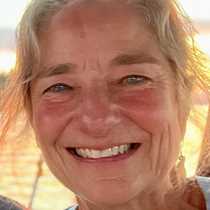Embera Village
We disembarked the ship, and cayucos (dugout canoes) transported us across the shallow bay, and up the narrow, winding Mogue River. Along the mangrove-lined river, herons stood at water’s edge, roseate spoonbills perched on trees, and parrots flew high overhead. Our visit to the remote Embera village had to be timed around the high tide; otherwise the river was just too shallow.
Our arrival at the village was unforgettable. Beautifully decorated women stood in a line atop the riverbank, while men played traditional Embera music. The flute sounded especially lovely, played by the best known Embera musician in the region.
As we began walking towards the village, a young girl reached for my hand and looked up into my eyes . . . and my heart melted. She kept hold of my hand as we walked down the path. We saw several large butterflies along the way.
The Embera people paint their skin using juice from a forest berry. The geometric patterns decorate their bodies from the mouth down. My very young new friend had a bird painted on her back. The skin paint lasts about two weeks, so I expect that my large, new ‘tattoo bracelet’ will disappear by early November.
In the village, stilt homes had thatched roofs but lacked walls, a smart design for a very hot, wet environment. Children walked freely on the open grass throughout the village. I did a double-take when I saw the phone booth near the village center; it seemed very out of place!
Three villagers were busy squeezing sugarcane between two wooden rollers. The sweet juice collected in a basin made from banana leaves. It will ferment to produce alcoholic. Men played music for us, and young women performed several traditional dances before laying out their handicrafts: finely woven baskets and carvings made from tagua nut (vegetable ivory), and rosewood.
This village is in the wild, sparsely populated Darien rainforest. Because of its remoteness and its proximity to Columbia, the area is occasionally patrolled by uniformed Panamanian frontier police. Even they seemed relaxed and friendly, but their large guns did not. Our morning excursion was indescribably rich and utterly memorable. We had been so warmly welcomed, and introduced to a lifestyle completely different from our own.
The ship got underway, and sharp eyes sighted a young humpback whale swimming slowly alongside its mother. Nearby there was another mother/calf pair, but they were very active; the calf slapped its flippers and tail flukes, and then lunged repeatedly out of the water. This region in the Bay of Panama is an important tropical breeding area for humpbacks that feed in rich Antarctic waters.
Late in the afternoon Olga gave a talk about indigenous peoples. This rich, full day concluded with the Captain’s Welcome Cocktail Party and Dinner.
We disembarked the ship, and cayucos (dugout canoes) transported us across the shallow bay, and up the narrow, winding Mogue River. Along the mangrove-lined river, herons stood at water’s edge, roseate spoonbills perched on trees, and parrots flew high overhead. Our visit to the remote Embera village had to be timed around the high tide; otherwise the river was just too shallow.
Our arrival at the village was unforgettable. Beautifully decorated women stood in a line atop the riverbank, while men played traditional Embera music. The flute sounded especially lovely, played by the best known Embera musician in the region.
As we began walking towards the village, a young girl reached for my hand and looked up into my eyes . . . and my heart melted. She kept hold of my hand as we walked down the path. We saw several large butterflies along the way.
The Embera people paint their skin using juice from a forest berry. The geometric patterns decorate their bodies from the mouth down. My very young new friend had a bird painted on her back. The skin paint lasts about two weeks, so I expect that my large, new ‘tattoo bracelet’ will disappear by early November.
In the village, stilt homes had thatched roofs but lacked walls, a smart design for a very hot, wet environment. Children walked freely on the open grass throughout the village. I did a double-take when I saw the phone booth near the village center; it seemed very out of place!
Three villagers were busy squeezing sugarcane between two wooden rollers. The sweet juice collected in a basin made from banana leaves. It will ferment to produce alcoholic. Men played music for us, and young women performed several traditional dances before laying out their handicrafts: finely woven baskets and carvings made from tagua nut (vegetable ivory), and rosewood.
This village is in the wild, sparsely populated Darien rainforest. Because of its remoteness and its proximity to Columbia, the area is occasionally patrolled by uniformed Panamanian frontier police. Even they seemed relaxed and friendly, but their large guns did not. Our morning excursion was indescribably rich and utterly memorable. We had been so warmly welcomed, and introduced to a lifestyle completely different from our own.
The ship got underway, and sharp eyes sighted a young humpback whale swimming slowly alongside its mother. Nearby there was another mother/calf pair, but they were very active; the calf slapped its flippers and tail flukes, and then lunged repeatedly out of the water. This region in the Bay of Panama is an important tropical breeding area for humpbacks that feed in rich Antarctic waters.
Late in the afternoon Olga gave a talk about indigenous peoples. This rich, full day concluded with the Captain’s Welcome Cocktail Party and Dinner.


